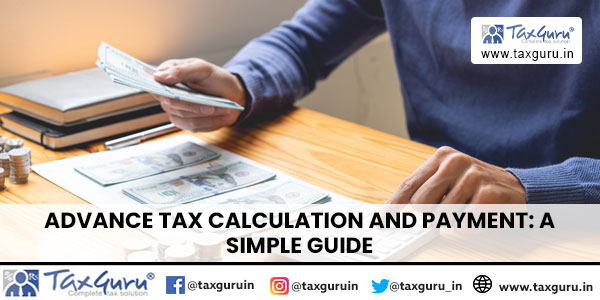‘Pay-as-you-earn’ is the basic fundamental on which advance tax under Income Tax works. In nut-shell, advance tax is simply income tax paid in advance. Notably, provisions of sections 208 and 209 of the Income Tax Act, 1961 governs the advance tax.
The advance tax applies to all taxpayers whose estimated tax liability in a Financial Year is more than INR 10,000. However, taxpayers aged 60 years or above (i.e. senior citizens) who do not have any income from business or profession are exempt from payment of advance tax.
In the present article, let us clear up the basic concept of advance tax calculation and advance tax payment.

Advance Tax Calculation –
Advance tax calculation will vary from person to person. However, one can follow the below steps for advance tax calculation –
STEP 1 – First, estimate the total income for the respective Financial Year under all the five heads of income [i.e. Income from Salary, Income from house property, Income from business or profession, Income from capital gains and Income from other sources];
STEP 2 – Calculate all the eligible deductions and exemptions;
STEP 3 – Compute net estimated total income;
[Net estimated total income = Total income as estimated at step 1 (-) all eligible deductions and exemptions as calculated at step 2];
STEP 4 – Calculate tax on net estimated total income as per preferred tax regime;
STEP 5 – Now, arrive at the net tax payable by giving the effect of tax already paid in the form of Tax Deduction at Source (TDS) or Tax Collected at Source (TCS).
Notably, advance tax is to be paid on the amount arrived at STEP 5 above.
Advance Tax Payment –
Due date of payment of Advance Tax are tabulated hereunder –
| Due date for individual and corporate taxpayers – | ||
| Instalment | Due date | Amount of advance tax |
| 1st Instalment | On or before 15th June | 15% of the estimated tax liability |
| 2nd Instalment | On or before 15th September | 45% of the estimated tax liability (-) advance tax already paid |
| 3rd Instalment | On or before 15th December | 75% of the estimated tax liability (-) advance tax already paid |
| 4th Instalment | On or before 15th March | 100% of the estimated tax liability (-) advance tax already paid |
| Due date for taxpayers who opted under the presumptive taxation scheme under section 44AD/ 44ADA – | ||
| On or before 15th March | 100% of the estimated tax liability | |
Advance Tax Payment [online and offline mode explained] –
Steps for Online mode of advance tax payment –
STEP 1 – Go to the e-filing portal i.e. https://www.incometax.gov.in/iec/foportal/;
STEP 2 – Select ‘e-Pay Tax’ from options under ‘Quick Links’;
STEP 3 – Enter PAN and re-enter PAN to confirm it. Now, enter mobile number and click Continue.
STEP 4 – Enter OTP and click Continue. Now, press ‘Proceed’ under the ‘Income Tax’ tab;
STEP 5 – From the drop-down list, select the relevant Assessment Year and Type of Payment as ‘Advance Tax (100)’. Now, click Continue;
STEP 6 – Enter relevant tax details i.e. the amount paid towards tax, surcharge, cess, interest, penalty and others and click ‘Continue’;
STEP 7 – Select the Payment Mode [i.e. net banking, credit card or debit card] and enter required payment details. Now, click ‘Submit’;
STEP 8 – A preview of the challan will be displayed, verify the details and click ‘Pay Now’.
Steps for Offline mode of advance tax payment –
STEP 1 – Obtain a hard copy of challan 280;
STEP 2 – Fill up the Challan 280 with personal details, PAN, Assessment Year and tax payment details;
STEP 3 – Submit filled Challan 280 with the authorized bank, along with payment.






Beautiful brief discussion with every clarity. No question remains unanswered. Thanks.